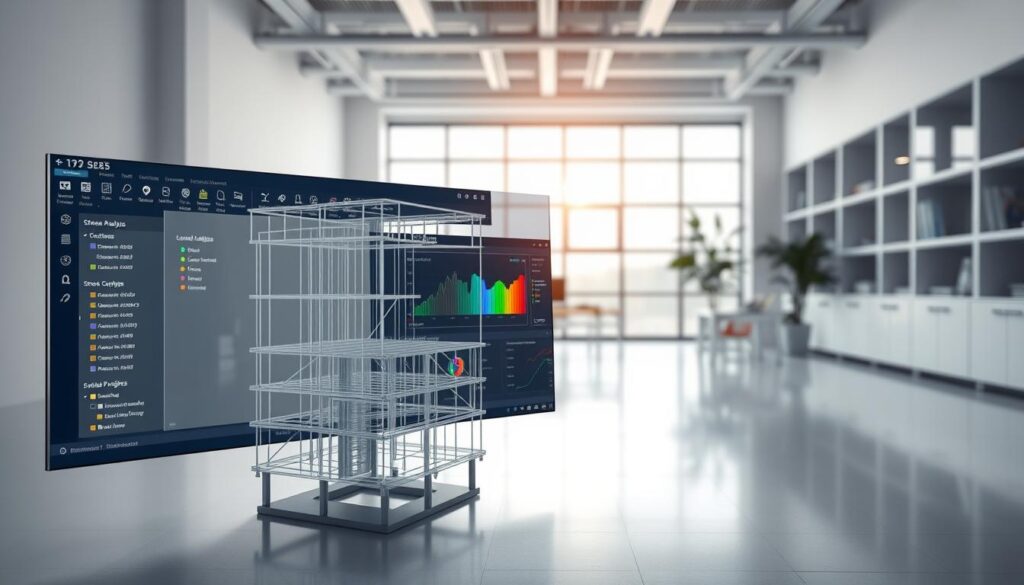The construction industry is witnessing a significant transformation with the adoption of cloud-based structural analysis and design software. Did you know that a staggering 14,648,117 projects have been solved using such innovative tools?
With SkyCiv, a comprehensive suite of building analysis software is available, supporting a wide range of steel, wood, and concrete design codes. This civil engineering software is accessible anywhere from your browser, making it a powerful and easy-to-use solution for optimizing building plans.
Key Takeaways
- Cloud-based structural analysis and design software for optimizing building plans.
- Comprehensive suite of building analysis software tools.
- Supports various steel, wood, and concrete design codes.
- Accessible from any browser, enhancing collaboration and productivity.
- Flexible subscription options for individuals and organizations.
Introduction to Structural Analysis Software
Structural analysis software is a cornerstone in contemporary engineering, enabling professionals to assess complex structures with heightened accuracy and speed. This software has become indispensable in the field of structural engineering, where precision and efficiency are paramount.
What Is Structural Analysis Software?
Structural analysis software is designed to analyze the integrity and stability of structures under various loads and conditions. It allows engineers to simulate real-world scenarios, predict potential failures, and optimize designs. By leveraging advanced algorithms and simulation techniques, this software provides a comprehensive understanding of how structures behave under different stresses.
For those interested in learning more about applying such software in civil engineering, resources like how to use AutoCAD for civil can be invaluable.
Importance in Modern Engineering
The importance of structural analysis software in modern engineering cannot be overstated. It has revolutionized the way engineers design, analyze, and optimize structures. By enabling the simulation of various scenarios, it helps in identifying potential issues early in the design process, thereby reducing costs and improving safety.
Advanced structural analysis software is particularly crucial for complex projects, where it aids in ensuring compliance with regulatory standards and enhancing the overall efficiency of the design process.
Overview of Key Features
Key features of structural analysis software typically include advanced simulation capabilities, user-friendly interfaces, and integration with CAD systems. These features facilitate a seamless workflow from design to analysis, enabling engineers to make informed decisions based on detailed insights.
- Advanced simulation capabilities for accurate analysis
- User-friendly interfaces for ease of use
- Integration with CAD systems for streamlined workflow
By understanding and leveraging these features, engineers can significantly enhance the quality and efficiency of their structural designs.
Benefits of Using Structural Analysis Software

The best structural analysis software tools offer numerous benefits to engineers and architects, enhancing their ability to design and analyze complex structures. By leveraging these advanced tools, professionals can streamline their workflows, improve accuracy, and reduce costs.
Increased Efficiency in Design
One of the primary advantages of using structural analysis software is the increased efficiency it brings to the design process. With features like automated load calculations and advanced simulation capabilities, engineers can quickly iterate through different design scenarios, optimizing their structures for performance and cost.
For instance, Autodesk Revit is a popular choice among architects and engineers due to its comprehensive design and analysis capabilities. It allows users to create detailed building models and perform structural analysis, thereby streamlining the design process.
“The use of structural analysis software has been a game-changer for our firm. We’ve seen a significant reduction in design time and an improvement in overall project quality.”
Improved Accuracy and Safety
Structural analysis software also improves the accuracy and safety of building designs. By using advanced algorithms and simulation techniques, engineers can identify potential issues before they become major problems, ensuring that structures are safe and compliant with relevant building codes.
| Software | Key Features | Benefits |
|---|---|---|
| SAP2000 | Advanced simulation, dynamic analysis | Improved accuracy, enhanced safety |
| ETABS | 3D modeling, seismic analysis | Better structural performance, compliance with building codes |
Cost Savings Over Time
In addition to improving efficiency and accuracy, structural analysis software can also lead to significant cost savings over time. By optimizing designs and reducing the need for physical prototypes, engineers can minimize material waste and lower construction costs.
Furthermore, the use of top structural analysis tools can help firms stay competitive by delivering high-quality projects on time and within budget. As the industry continues to evolve, the adoption of advanced structural design software will become increasingly important for companies looking to stay ahead of the curve.
Popular Structural Analysis Software Options
With numerous options available, choosing the right structural analysis software is crucial for optimizing building plans. The selection of software can significantly impact the efficiency, accuracy, and cost-effectiveness of engineering projects.
Autodesk Revit
Autodesk Revit is a powerful tool that combines architectural design, engineering, and construction in one platform. It allows for Building Information Modeling (BIM), which enhances collaboration across different disciplines. Revit’s capabilities in structural analysis make it a popular choice among engineers and architects alike.
SAP2000
SAP2000 is a comprehensive software for structural analysis and design. It is particularly noted for its ability to handle complex structures and provide detailed analysis reports. Engineers use SAP2000 for a wide range of projects, from simple to highly complex structures, benefiting from its advanced simulation capabilities.
For more insights on the relationship between structural engineering and architecture, visit this resource.
ETABS
ETABS is another widely used software for structural analysis, particularly for building structures. It offers advanced features for static and dynamic analysis, helping engineers to optimize their designs for safety and efficiency. ETABS is known for its user-friendly interface and powerful analysis capabilities.
These civil engineering software options have transformed the field of structural analysis, enabling professionals to create more accurate and efficient building plans. By leveraging the right building analysis software, engineers can significantly improve project outcomes.
Key Features to Look for in Software

Effective structural analysis software is characterized by its ability to provide user-friendly interfaces, advanced simulation capabilities, and seamless integration with CAD systems. When evaluating different options, it’s crucial to consider these features to ensure the chosen software meets your project’s specific needs.
User-Friendly Interfaces
A user-friendly interface is vital for reducing the learning curve and enhancing productivity. Look for software that offers an intuitive design, clear navigation, and customizable dashboards. This enables engineers to focus on design and analysis rather than struggling with the software itself.
Advanced Simulation Capabilities
The ability to perform advanced simulations is a hallmark of top structural analysis tools. This includes capabilities such as dynamic analysis, nonlinear analysis, and thermal analysis. Such features allow for a more accurate assessment of a structure’s behavior under various conditions, ensuring safety and efficiency.
Integration with CAD Systems
Integration with CAD systems is another critical feature. It enables seamless data transfer between the structural analysis software and the CAD program, reducing errors and saving time. This integration is essential for maintaining consistency across different stages of the design and analysis process.
By focusing on these key features, engineers and architects can select the most appropriate advanced structural analysis software for their needs, enhancing their design and analysis capabilities.
How Structural Analysis Software Works
By leveraging advanced algorithms and computational power, structural analysis software enables engineers to simulate and predict the behavior of structures under various conditions. This capability is crucial for ensuring the safety, efficiency, and cost-effectiveness of construction projects.
Basic Principles of Structural Analysis
Structural analysis software is grounded in the fundamental principles of physics and mathematics. It applies these principles to analyze the structural integrity of buildings, bridges, and other infrastructure projects. The software considers factors such as material properties, loads, and boundary conditions to predict how a structure will behave under different scenarios.
Different Methods of Analysis
There are several methods of analysis that structural analysis software can perform, including:
- Static analysis: Examines the structure’s response to static loads.
- Dynamic analysis: Analyzes the structure’s response to dynamic loads, such as earthquakes or wind.
- Nonlinear analysis: Considers the nonlinear behavior of materials and structures.
| Method of Analysis | Description | Application |
|---|---|---|
| Static Analysis | Examines the structure’s response to static loads. | Building design, bridge design |
| Dynamic Analysis | Analyzes the structure’s response to dynamic loads. | Seismic design, wind engineering |
| Nonlinear Analysis | Considers the nonlinear behavior of materials and structures. | Advanced material research, complex structural analysis |
Real-Time Data Processing
One of the key features of modern structural analysis software is its ability to process data in real-time. This allows engineers to make timely decisions and adjustments during the design and analysis process. Real-time data processing enhances collaboration among team members and facilitates a more iterative and responsive design process.
Benefits of Real-Time Data Processing:
- Improved collaboration among team members.
- Enhanced decision-making capabilities.
- Faster iteration and adaptation during the design process.
The Role of Software in Sustainable Design

Sustainable design is becoming increasingly important, and structural analysis software plays a vital role in this endeavor by optimizing energy efficiency and material usage. As the construction industry moves towards more environmentally friendly practices, the role of software in achieving these goals cannot be overstated.
Energy Efficiency Considerations
One of the primary ways structural analysis software contributes to sustainable design is through energy efficiency considerations. By using advanced simulation tools, engineers can analyze how different design elements impact a building’s energy consumption. This allows for the optimization of building plans to minimize energy usage, reducing both the environmental footprint and operational costs.
Key features of structural analysis software that support energy efficiency include:
- Advanced thermal analysis tools
- Daylighting analysis to maximize natural light
- Energy consumption modeling
Material Optimization
Material optimization is another critical aspect of sustainable design that structural analysis software addresses. By analyzing the structural integrity of different materials and designs, engineers can select the most efficient and sustainable materials for their projects. This not only reduces waste but also minimizes the environmental impact of sourcing and processing materials.
The software enables detailed analysis of various materials, allowing engineers to:
- Compare the sustainability of different materials
- Optimize structural designs to use less material
- Select materials with lower environmental impacts
Lifecycle Analysis Tools
Lifecycle analysis tools within structural analysis software provide a comprehensive assessment of a building’s environmental impact throughout its entire lifecycle, from construction to demolition. This holistic view enables engineers and architects to make informed decisions that reduce the overall environmental footprint of their projects.
By utilizing lifecycle analysis tools, professionals can:
- Assess the long-term sustainability of their designs
- Identify areas for improvement in the building lifecycle
- Make data-driven decisions to enhance sustainability
In conclusion, structural analysis software is a powerful tool in the pursuit of sustainable design. By leveraging its capabilities in energy efficiency considerations, material optimization, and lifecycle analysis, engineers and architects can create buildings that are not only structurally sound but also environmentally friendly.
Industry Applications of Structural Analysis Software
From residential buildings to complex infrastructure projects, structural analysis software plays a pivotal role in modern construction. Its versatility and advanced features enable engineers and architects to design, analyze, and optimize structures across various industries.
Residential Building Design
In residential building design, structural analysis software is used to ensure that homes and apartments are safe, durable, and compliant with building codes. It allows for the simulation of various loads and stresses, helping to identify potential weaknesses and optimize the structure. For instance, software like Autodesk Revit enables architects to create detailed models and analyze the structural integrity of residential buildings.
Key benefits include improved safety, reduced material costs, and enhanced energy efficiency. By analyzing different design scenarios, builders can make informed decisions that impact the long-term performance of the building.
Commercial Structures
For commercial structures, such as office buildings and shopping centers, structural analysis software is crucial for handling complex designs and large-scale projects. It facilitates the analysis of various structural systems, including steel and concrete frames, and ensures compliance with local building regulations.
As noted by industry experts, “The use of advanced structural analysis software has become a standard practice in the design of commercial structures, enabling the creation of more efficient and sustainable buildings.” This shift towards more sophisticated analysis tools has significantly impacted the industry, allowing for greater innovation and precision.
Infrastructure Projects
Infrastructure projects, including bridges, tunnels, and highways, require precise structural analysis to ensure public safety and longevity. Structural analysis software is used to model and analyze the complex interactions between different components of infrastructure projects, helping to identify potential issues before they become major problems.
The software enables engineers to simulate various scenarios, including natural disasters and heavy traffic loads, to ensure that infrastructure projects are resilient and meet stringent safety standards. By leveraging advanced analysis capabilities, engineers can optimize designs and reduce maintenance costs over the lifecycle of the infrastructure.
In conclusion, structural analysis software has a wide range of industry applications, from residential building design to complex infrastructure projects. Its ability to simulate, analyze, and optimize structures makes it an indispensable tool in modern construction and engineering.
Customization and Scalability

Effective structural analysis software must be both customizable and scalable to accommodate varying project scopes and complexities. This flexibility is crucial for ensuring that the software meets the specific needs of different projects and teams.
Tailoring Software for Specific Projects
Customization allows users to tailor the software to their specific project requirements. This can include adjusting the user interface, selecting specific analysis tools, and configuring the software to work with particular file formats or data types. For instance, a project that involves complex bridge design might require advanced simulation capabilities that can be enabled through customization.
Key customization features in structural engineering software may include:
- Personalizable user interfaces
- Modular analysis tools
- Compatibility with various data formats
Adapting to Team Size and Project Scope
Scalability is equally important as it allows the software to adapt to the size of the team and the scope of the project. Whether you’re working on a small renovation or a large infrastructure project, scalable software can grow with your needs. This means that the software should be able to handle increased data loads, additional users, and more complex analyses as required.
Scalability considerations include:
- Ability to handle large datasets
- Support for multiple users
- Flexibility in analysis capabilities
| Feature | Small Projects | Large Projects |
|---|---|---|
| Data Handling | Limited dataset support | Large dataset support |
| User Support | Fewer user licenses | Multiple user licenses |
| Analysis Capabilities | Basic analysis tools | Advanced analysis tools |
In conclusion, when selecting structural analysis software, it’s essential to consider both customization and scalability. By choosing software that can be tailored to your project’s specific needs and can scale according to the project’s size and complexity, you can ensure more efficient and effective project execution.
Collaboration Features in Software
The ability to collaborate seamlessly is a hallmark of advanced structural analysis software. In today’s complex engineering projects, effective collaboration is not just beneficial; it’s essential. Structural analysis software now includes a range of collaboration features that enable multidisciplinary teams to work together more effectively.
Multidisciplinary Team Integration
One of the key collaboration features in modern structural analysis software is the ability to integrate multidisciplinary teams. This means that architects, engineers, and contractors can work together within the same software environment, sharing data and insights in real-time. Autodesk Revit, for example, allows for comprehensive project development by integrating various disciplines into a single model.
Real-Time Collaboration Tools
Real-time collaboration tools are another critical feature of contemporary structural analysis software. These tools enable team members to collaborate on designs and analyses simultaneously, regardless of their geographical location. This not only speeds up the design process but also reduces the likelihood of errors. SAP2000 and ETABS are examples of software that offer advanced real-time collaboration capabilities.
Sharing and Reporting Features
Effective collaboration also involves the ability to share and report project data efficiently. Structural analysis software often includes features that allow users to generate detailed reports and share them with stakeholders. This can include visual representations of the structural analysis, making it easier for non-technical stakeholders to understand the project’s status and progress.
By incorporating these collaboration features, structural analysis software significantly enhances the productivity and efficiency of engineering teams. As the industry continues to evolve, the importance of seamless collaboration will only continue to grow.
The Future of Structural Analysis Analysis

The future of structural analysis is being shaped by emerging technologies that promise to revolutionize the field. As we look ahead, it’s clear that artificial intelligence (AI) and cloud computing will play significant roles in transforming structural analysis software.
One of the key emerging technologies is AI, which is being integrated into structural analysis software to enhance design optimization and predictive analysis. According to a report on the evolution of structural analysis software, AI-driven tools are becoming increasingly sophisticated, allowing for more accurate and efficient analysis.
Cloud computing is another technology that is transforming the field by enabling real-time collaboration and data sharing. This allows teams to work together more effectively, regardless of their geographical location. For instance, AI is transforming civil engineering by providing more precise simulations and analyses, which can lead to safer and more sustainable structures.
The future of structural analysis will also be characterized by increased use of advanced materials and construction techniques. Software will need to adapt to these changes by incorporating new materials’ properties and behaviors into their analysis capabilities.
| Emerging Technology | Impact on Structural Analysis | Benefits |
|---|---|---|
| Artificial Intelligence | Enhanced design optimization and predictive analysis | More accurate and efficient analysis |
| Cloud Computing | Real-time collaboration and data sharing | Improved teamwork and reduced project timelines |
| Advanced Materials | Incorporation of new materials’ properties into analysis | Safer and more sustainable structures |
As these technologies continue to evolve, we can expect structural analysis software to become even more powerful and intuitive. The integration of emerging technologies will not only enhance the capabilities of structural analysis but also contribute to the development of more sustainable and resilient infrastructure.
Training and Support for Structural Analysis Software
To get the most out of structural analysis software, comprehensive training and ongoing support are essential. This ensures that users can effectively utilize the software’s features to enhance their engineering projects.
Available Resources for Learning
Most structural analysis software providers offer a variety of resources to help users get started and improve their skills. These resources include:
- Detailed documentation and user manuals that cover all aspects of the software.
- Video tutorials that provide step-by-step guidance on using the software’s key features.
- Webinars and online workshops that offer interactive learning experiences.
- Training courses, both online and in-person, tailored to different skill levels.
Importance of Ongoing Support
Ongoing support is critical for addressing any issues that arise during the use of structural analysis software. This support can come in various forms, including:
- Technical support teams available to answer questions and resolve problems.
- Regular software updates that ensure the software remains compatible with the latest operating systems and hardware.
- Community support through user forums and discussion groups where users can share knowledge and solutions.
User Communities and Forums
User communities and forums play a vital role in the ecosystem of structural analysis software. They provide a platform for users to:
- Share experiences and best practices.
- Seek advice from more experienced users.
- Discuss new features and suggest improvements.
By engaging with these communities, users can enhance their learning and stay updated on the latest developments in structural analysis software.
Cost Considerations

When evaluating structural analysis software, understanding the cost implications is crucial for making an informed decision. The total cost of ownership includes not just the initial purchase or subscription fee but also ongoing costs such as maintenance, updates, and training.
Pricing Models Comparison
Different software providers offer various pricing models, including perpetual licenses, subscription-based services, and free versions. Perpetual licenses involve a one-time payment for the software, while subscription-based models require recurring payments, often monthly or annually.
| Pricing Model | Initial Cost | Ongoing Costs | Flexibility |
|---|---|---|---|
| Perpetual License | High | Low (maintenance) | Low |
| Subscription-Based | Low | Medium to High | High |
| Free Version | None | Low (optional upgrades) | Medium |
Free vs. Paid Software Options
Free structural analysis software can be a good starting point, especially for small projects or individuals. However, paid options often provide more advanced features, better support, and greater scalability. For instance, computational cost analysis can be more accurately performed with paid software, potentially leading to significant cost savings over time.
Return on Investment Analysis
Conducting a return on investment (ROI) analysis is essential to understand the financial benefits of investing in structural analysis software. This involves comparing the costs of the software against the savings and efficiencies it brings to your projects. Factors to consider include increased productivity, reduced material waste, and the ability to take on more complex projects.
By carefully evaluating these aspects, you can make a more informed decision about which structural analysis software best fits your needs and budget, ensuring a positive return on investment.
Case Studies of Successful Software Implementation
Successful implementation of structural analysis software is well-documented in various case studies across the engineering sector. These case studies provide valuable insights into how the software can be effectively used to improve project outcomes.
Real-World Examples
Several companies have successfully integrated structural analysis software into their workflow. For instance, a leading construction firm used Autodesk Revit to optimize their building designs, resulting in a 20% reduction in material costs. Another example is a bridge construction project that utilized SAP2000 for structural analysis, leading to improved safety and durability.
Lessons Learned from Implementation
From these case studies, several lessons can be learned. Firstly, the importance of proper training for users cannot be overstated. Companies that invested in comprehensive training saw a smoother transition to the new software. Secondly, the need for continuous support from the software provider is crucial for addressing any issues that arise during implementation.
Benefits Realized by Companies
The benefits realized by companies that have successfully implemented structural analysis software are numerous. A summary of these benefits is provided in the table below:
| Company | Software Used | Benefits Realized |
|---|---|---|
| Construction Firm A | Autodesk Revit | 20% reduction in material costs, improved design efficiency |
| Bridge Construction Project | SAP2000 | Improved safety, enhanced durability of the structure |
| Architecture Firm B | ETABS | Increased accuracy in structural analysis, faster project completion |
These case studies demonstrate the potential of structural analysis software to transform the engineering industry by improving efficiency, safety, and cost-effectiveness.
Challenges in Adopting New Software

Implementing new structural analysis software is not without its hurdles. Companies often face a myriad of challenges that can impact the successful adoption of new technology.
Learning Curve for New Users
One of the primary challenges is the learning curve associated with new software. Employees must be trained to use the new tools effectively, which can be time-consuming and may require significant resources. For instance, a company adopting Autodesk Revit may need to invest in comprehensive training programs to ensure that their team can leverage the software’s advanced features.
To mitigate this, companies can adopt a phased training approach, starting with basic functionalities and gradually moving to more complex features. This helps in reducing the overwhelm and allows users to become proficient over time.
Resistance to Change in Companies
Another significant challenge is resistance to change within the organization. Employees who are accustomed to traditional methods may be hesitant to adopt new software, fearing it might complicate their workflow or render their existing skills obsolete.
Addressing this resistance requires effective change management strategies. Leaders can facilitate this by communicating the benefits of the new software, such as improved efficiency and enhanced collaboration capabilities. For example, a company might highlight how the new software allows for real-time collaboration, making projects more manageable and improving overall team productivity.
Maintenance and Updates
After the initial adoption, maintaining and updating the software is crucial. This involves ensuring that the software remains compatible with evolving industry standards and that any issues are promptly addressed.
Regular updates can sometimes introduce new challenges, such as compatibility issues with other software or changes to the user interface that may confuse existing users. A well-planned maintenance schedule and user support system can help mitigate these issues.
| Challenge | Description | Mitigation Strategy |
|---|---|---|
| Learning Curve | Employees need training to use new software effectively. | Phased training programs. |
| Resistance to Change | Employees are hesitant to adopt new software. | Effective change management and communication of benefits. |
| Maintenance and Updates | Ensuring software remains compatible and up-to-date. | Regular maintenance schedules and user support. |
Regulatory Compliance and Standards
Regulatory compliance is a key consideration in the selection and utilization of structural analysis software. Ensuring that the software meets all relevant regulatory standards is crucial for the safety, efficiency, and legality of construction projects.
Understanding Building Codes
Building codes are sets of regulations that govern the design, construction, and occupancy of buildings. Understanding and complying with these codes is essential for structural engineers and architects. Structural analysis software must be capable of helping users adhere to these codes, which can vary significantly by jurisdiction.
For instance, in the United States, the International Building Code (IBC) and the International Residential Code (IRC) provide comprehensive guidelines for building design and construction. Software that is compliant with these codes can significantly reduce the risk of non-compliance.
Software and Compliance Tracking
Modern structural analysis software often includes features designed to track and ensure compliance with relevant building codes and standards. Automated compliance checking can help identify potential issues early in the design process, reducing the likelihood of costly revisions later on.
- Automated code checking
- Real-time compliance tracking
- Alerts for non-compliant designs
These features not only streamline the compliance process but also enhance the overall efficiency of the design and construction workflow.
Keeping Up with Industry Standards
Industry standards, such as those set by the American Society of Civil Engineers (ASCE), play a critical role in ensuring the quality and safety of construction projects. Structural analysis software must be updated regularly to reflect changes in these standards.
“Staying current with industry standards is not just about compliance; it’s about ensuring the safety and integrity of the structures we design and build.” – ASCE President
By keeping software up to date with the latest standards, professionals can ensure that their designs meet the highest standards of safety and efficiency.
In conclusion, regulatory compliance and adherence to industry standards are fundamental aspects of using structural analysis software effectively. By understanding building codes, leveraging software features for compliance tracking, and staying current with industry standards, professionals can maximize the benefits of their software investment.
Conclusion: Choosing the Right Structural Analysis Software
Selecting the ideal structural analysis software is crucial for optimizing building plans and ensuring project success. With numerous options available, decision-makers must consider several key factors to make an informed choice.
Key Takeaways for Decision Makers
When choosing the right software, consider factors such as compliance with standards, scalability, user-friendliness, and integration capabilities. Engineers spend up to 30% of their time managing data manually, and 1% of all spreadsheet formula cells contain errors, highlighting the need for efficient and accurate software.
Future-Proofing Your Software Investment
Future-proofing involves selecting a solution that adapts to evolving project complexities and industry standards. This includes considering software that offers advanced simulation capabilities and real-time data processing.
Final Thoughts on Optimization Strategies
To optimize structural analysis, teams should prioritize software that enhances collaboration and provides robust support. By doing so, teams can improve efficiency and overall project outcomes, driving success in their structural engineering endeavors.
